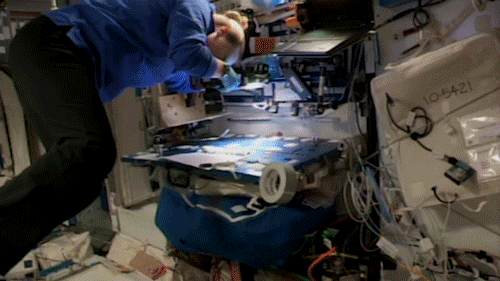ISS - Expedition 64 Mission patch.
Feb 21, 2021
Scientific investigations conducted aboard the International Space Station the week of Feb. 15 included studies of flame spread in confined spaces, direct RNA sequencing from tissue samples, and acoustic monitoring of equipment. Crew members finalized preparations for the arrival of new supplies and scientific experiments aboard the NG-15 cargo craft, scheduled to launch Feb. 20.
Image above: This oblique view of Mount Ararat in eastern Turkey was taken as the International Space Station orbited 262 miles above Iran just south of the Caspian Sea. Image Credit: Roscosmos.
The seven crew members currently inhabiting the station include four from NASA’s Commercial Crew Program, providing increased crew time for science activities on the orbiting lab. The space station has been continuously inhabited by humans for 20 years and has supported many scientific breakthroughs during that time. The station provides a platform for long-duration research in microgravity and for learning to live and work in space, experience that supports Artemis, NASA’s program to go forward to the Moon and on to Mars.
Here are details on some of the microgravity investigations currently taking place:
Examining the behavior of flames
Image above: This fabric sample was part of operations for the Confined Combustion investigation, which examines flame spread in differently-shaped confined spaces in microgravity. Image Credit: NASA.
The crew installed hardware for the Confined Combustion investigation and conducted a flame test. This investigation examines the behavior of flames as they spread in differently-shaped spaces in microgravity, including the interactions between spreading flames and surrounding walls. Flame spread in confined spaces such as a spacecraft may pose a more serious fire hazard than in open spaces because heat radiating from the walls and flow conditions can accelerate flames. Observations from this investigation can be translated into mathematical models to help designers and planners anticipate fire behavior and create plans for preventing or extinguishing fires effectively in space.
Reading radish RNA
Animation above: NASA astronaut Kate Rubins works on the One-Step Gene Sampling Tool investigation, which uses radish samples to test a technology for genetic analysis of ribonucleic acid (RNA) directly from tissue. Animation Credit: NASA.
During the week, the crew set up hardware and performed analysis on a radish harvested from the station’s Advanced Plant Habitat for One-Step Gene Sampling Tool. This investigation tests a technology that collects ribonucleic acid (RNA) directly from tissue, enabling quick genetic analysis of multiple samples without the need to destroy the specimen. These brief and repeatable screenings could help researchers make more informed decisions about plant and animal growth investigations as well as extract a full genetic library from these organisms.
Listening in on equipment
Image above: An audio sensor for the SoundSee investigation floats in the space station. SoundSee tests using these sensors on the Astrobee robotic platforms to monitor the station’s acoustic environment, which can provide early indication of equipment failure. Image Credit: NASA.
SoundSee tests a way to monitor the space station’s acoustic environment using monitors attached to free-flying Astrobee robots. Autonomous audio monitoring could detect equipment malfunction based on sound anomalies, helping to protect the health and safety of crew members by keeping equipment in good working order and reducing crew workload. During the week, crew members installed SoundSee onto an Astrobee and performed recordings.
Other investigations on which the crew performed work:
- VECTION, a Canadian Space Agency investigation, determines to what extent microgravity disrupts an astronaut's ability to visually interpret motion, orientation, and distance as well as how those abilities may adapt in space and change again upon return to Earth.
https://www.nasa.gov/mission_pages/station/research/experiments/explorer/Investigation.html?#id=7484
- Time Perception, an ESA (European Space Agency) experiment, quantifies the subjective changes in time perception that humans experience during and after long-duration spaceflight.
https://www.nasa.gov/mission_pages/station/research/experiments/explorer/Investigation.html?#id=7504
- Plant Water Management tests using concepts of capillary fluidics such as surface tension, wetting, and geometry to deliver adequate water and nutrients to plants.
https://www.nasa.gov/mission_pages/station/research/experiments/explorer/Investigation.html?#id=7884
- The 3D Microbial Monitoring investigation conducts a series of sample collections and uses DNA sequencing and other analyses to construct a three dimensional map of bacteria and bacterial products on surfaces in the space station.
https://www.nasa.gov/mission_pages/station/research/experiments/explorer/Investigation.html?#id=8345
- Bacterial Adhesion and Corrosion tests an antimicrobial coating on materials used to represent typical surfaces on the space station, which could provide insight into better ways to control and remove resistant biofilms for long-duration spaceflight.
https://www.nasa.gov/mission_pages/station/research/experiments/explorer/Investigation.html?#id=7956
- Antimicrobial Coatings tests a coating to control microbial growth on several different materials that represent high-touch surfaces. Some microbes change characteristics in microgravity, potentially creating new risks to crew health and spacecraft.
https://www.nasa.gov/mission_pages/station/research/experiments/explorer/Investigation.html?#id=8352
- Food Physiology characterizes how an enhanced spaceflight diet affects immune function, the gut microbiome, and nutritional status. Results could help define targeted, efficient dietary interventions to maintain crew health and performance.
https://www.nasa.gov/mission_pages/station/research/experiments/explorer/Investigation.html?#id=7870
- APM measures and quantifies the concentration of both small and large particles in cabin air as part of efforts to maintain air quality in the occupied environment on station, vital for the crew’s health.
https://www.nasa.gov/mission_pages/station/research/experiments/explorer/Investigation.html?#id=7936
- AstroRad Vest tests a wearable vest designed to protect astronauts from radiation caused by unpredictable solar particle events. Astronauts provide input on how easy the garment is to put on, how it fits and feels, and the range of motion it allows.
https://www.nasa.gov/mission_pages/station/research/experiments/explorer/Investigation.html?#id=7803
- The ISS Experience is creating an immersive virtual reality (VR) series documenting life and research aboard the space station using customized 360-degree cameras.
https://www.nasa.gov/mission_pages/station/research/experiments/explorer/Investigation.html?#id=7877
International Space Station (ISS). Animation Credit: ESA
Related links:
Expedition 64: https://www.nasa.gov/mission_pages/station/expeditions/expedition64/index.html
Commercial Crew Program: https://www.nasa.gov/exploration/commercial/crew/index.html
Confined Combustion: https://www.nasa.gov/mission_pages/station/research/experiments/explorer/Investigation.html?#id=7886
One-Step Gene Sampling Tool: https://www.nasa.gov/mission_pages/station/research/experiments/explorer/Investigation.html?#id=8021
SoundSee: https://www.nasa.gov/mission_pages/station/research/experiments/explorer/Investigation.html?#id=7860
Astrobee: https://www.nasa.gov/mission_pages/station/research/experiments/explorer/Facility.html?#id=1891
ISS National Lab: https://www.issnationallab.org/
Spot the Station: https://spotthestation.nasa.gov/
Space Station Research and Technology: https://www.nasa.gov/mission_pages/station/research/overview.html
International Space Station (ISS): https://www.nasa.gov/mission_pages/station/main/index.html
Images (mentioned), Animations (mentioned), Text, Credits: NASA/Michael Johnson/John Love, ISS Research Planning Integration Scientist Expedition 64.
Best regards, Orbiter.ch






